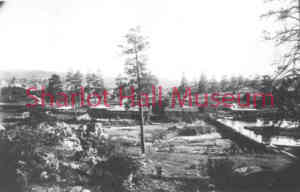By Michael King
May 14, 1948 Daily Courier Article:
“Let’s celebrate! Tomorrow will be one of the greatest days in the history of Prescott. It marks the turning of the gurgling, bubbling, crystal clear water of the Del Rio artesian basin into the mains of a thirsty city to end, at least for some time to come, the long water famine through which the city has struggled and gasped, lo, these many months.”
The City of Prescott has had a long history of securing dependable water supplies. Although Prescott was the Territorial Capital from 1864-67 and again from 1877-1889, it was not incorporated until February 27, 1883. Up until that time, wells and outhouses were the water sources and waste disposal systems. In 1881, four wells were installed on the four corners of the plaza. These wells were primarily for fire protection around the plaza. In 1884, after incorporation as the City of Prescott, a centralized system was developed by damming Miller Creek and pumping water up into a reservoir on the hill currently known as Cross Hill or Palmer Hill above Mount Vernon Street. From there, a gravity system delivered water to the residents below. The original wood-fired boiler and pump station existed in a brick building currently located in the Arizona Public Service yard at the foot of McCormick Street. This yard is directly adjacent to the Miller Creek dam which can be seen along the Creekside trail at the end of Campbell Street. The Miller Creek facilities replaced the four wells on the plaza as hydrants were installed near the city center.
 Over the next few decades other sources were developed. In 1891, a well was located at Goose Flat which is directly north of Prescott’s Mile High Middle school.
Over the next few decades other sources were developed. In 1891, a well was located at Goose Flat which is directly north of Prescott’s Mile High Middle school.
In 1899, a dam was constructed at the confluence of the North Fork Granite Creek and Granite Creek at the edge of the current Yavapai-Prescott Indian Tribe reservation boundary. This is directly behind KYCA/KAHM radio stations on Easy Street.
The Miller Creek dam and pumping facilities and the Goose Flat wells were discontinued at that time, so in 1900 the North Fork and Granite Creek facilities were the sole water source for fighting the catastrophic July 14, 1900, Whiskey Row Fire. This debunks the urban myth that the four wells on the Plaza went dry during the firefighting effort. They had long been out of use since 1884.
In 1901, a well and pump system at Del Rio Springs north of Chino Valley was developed and water was pumped 19 miles uphill to Prescott’s Mount Vernon Street reservoir.
 In 1907, the City of Prescott received a proposal from owners of Thorbeck Springs which was privately owned along what is now called Banning Creek. The city purchased water from them and built a pipeline down to the Mount Vernon Street reservoir. The Granite Creeks facilities required constant maintenance and were often polluted so they were discontinued. Therefore, the Del Rio Springs and Thorbeck Springs operations were Prescott’s water source from 1907 until the early 1920s. A comprehensive water study was under taken in 1919 with the recommendation to build a dam on Banning Creek, install a pipeline from the Hassayampa River near the Senator Highway and install supplementary pipelines from Wolf and Groom Creeks to add to the Banning Creek supply.
In 1907, the City of Prescott received a proposal from owners of Thorbeck Springs which was privately owned along what is now called Banning Creek. The city purchased water from them and built a pipeline down to the Mount Vernon Street reservoir. The Granite Creeks facilities required constant maintenance and were often polluted so they were discontinued. Therefore, the Del Rio Springs and Thorbeck Springs operations were Prescott’s water source from 1907 until the early 1920s. A comprehensive water study was under taken in 1919 with the recommendation to build a dam on Banning Creek, install a pipeline from the Hassayampa River near the Senator Highway and install supplementary pipelines from Wolf and Groom Creeks to add to the Banning Creek supply.
In 1923, the facilities were constructed, and the lake was named “Lake Goldwater” by vote of City Council to honor Mayor Morris Goldwater’s leadership throughout the years. The current upper “Goldwater Lake” in the city park was constructed in 1932 and Prescott once again relied predominately on surface water with gravity transport from the Mount Vernon Street reservoir. An infiltration gallery and well on Granite Creek near Sun Dog Road and a leased well (Weston Ranch) near where Basis School exists now augmented the Goldwater Basin supply system for several years. Del Rio Springs water and pipeline use ceased about 1937 due to the high cost of maintenance and bond costs. All water was pumped up to the reservoir site above Mount Vernon Street and distributed by gravity to the community below.
A review of City Council minutes, mayors’ annual reports, water studies and newspaper accounts from Prescott’s beginnings until just after WWII tell us of a history of voter approved bonds, extensive public meetings, contracting for studies and a diligent pursuit for dependable water supplies.
Next week, we’ll see how Prescott’s current water supply developed and recall the celebration of “The Biggest Splash.”
“Days Past” is a collaborative project of the Sharlot Hall Museum and the Prescott Corral of Westerners International (www.prescottcorral.org). This and other Days Past articles are also available at www.sharlothallmuseum.org/library-archives/days-past. The public is encouraged to submit proposed articles to dayspastshmcourier@gmail.com. Please contact SHM Library & Archives reference desk at 928-445-3122 Ext. 14, or via email at dayspastshmcourier@gmail.com for information.


